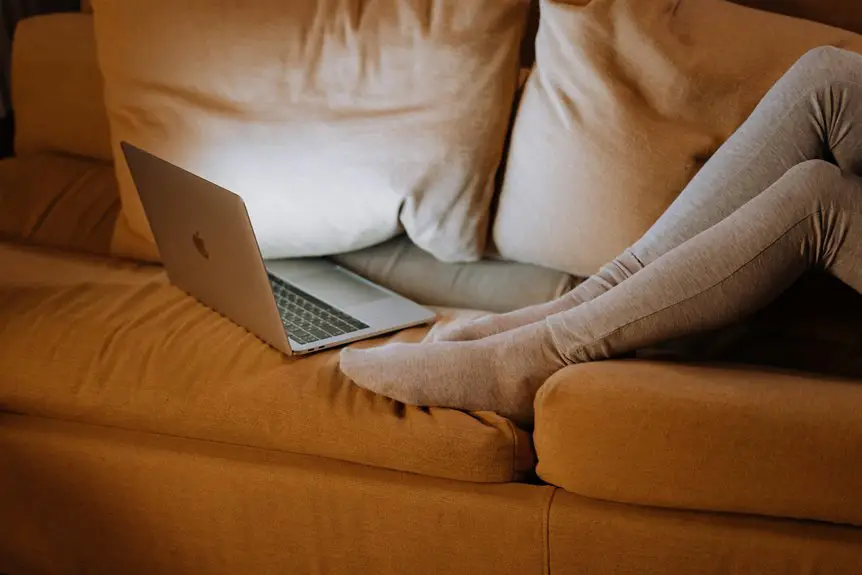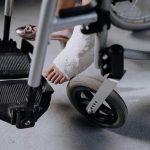To effectively elevate your legs while working from home, try using a footrest or an adjustable leg elevation pillow. Position your legs at about a 30-degree angle for ideal comfort. Take breaks every hour to elevate your legs for 15-20 minutes, and combine this with simple stretches to boost circulation. Make sure your chair supports good posture too. With these strategies, you can maintain your energy and productivity throughout the day, and there’s more to explore on this topic.
Table of Contents
Key Takeaways
- Use an adjustable footrest or ottoman to comfortably elevate your legs at a 30-degree angle while working.
- Incorporate leg elevation pillows for added comfort and support during extended work sessions.
- Take 15-20 minute breaks every hour to elevate your legs and improve circulation.
- Set reminders to adjust your position and stretch, promoting better posture and preventing discomfort.
- Personalize your workspace with appealing and functional items that encourage regular leg elevation.
Understanding the Benefits of Leg Elevation
While you mightn’t realize it, elevating your legs while working from home can considerably enhance your comfort and productivity. By propping your legs up, you improve blood circulation, reducing the risk of swelling and fatigue.
This simple adjustment can help alleviate pressure on your lower back and improve your posture as well. You’ll notice that taking regular breaks to elevate your legs can refresh your mind and body, boosting your focus and creativity.
Additionally, it can prevent discomfort that often leads to distraction, making it easier to stay on task. Whether you use a footrest or a stack of pillows, prioritizing leg elevation can transform your work experience and keep you energized throughout the day.
Choosing the Right Workspace Setup
To create a workspace that supports leg elevation, you need to take into account a few key factors.
Start with the ideal desk height that allows your arms to rest comfortably while typing.
Then, explore comfortable seating options and leg elevation accessories to enhance your overall comfort.
Optimal Desk Height
Choosing the right desk height is essential for maintaining comfort and productivity during long work hours. A desk that’s too high or too low can lead to strain and fatigue.
Here are some tips to help you find the ideal desk height:
- Your elbows should be at a 90-degree angle when typing.
- Your feet should rest flat on the floor or on a footrest.
- Your wrists should be straight and not bent while typing.
- The top of your monitor should be at eye level to avoid neck strain.
- Adjust your chair height to complement your desk setup.
Comfortable Seating Options
Finding the right seating option can greatly enhance your comfort and productivity while working from home. Start by considering an ergonomic chair that supports your lower back and encourages good posture.
Look for adjustable features, like seat height and armrests, to customize the fit to your body. If you prefer a more relaxed feel, a cushioned recliner can also provide comfort during long hours.
Don’t forget about the importance of material; breathable fabrics can help keep you cool and comfortable.
For those who like to move around, a stability ball or a kneeling chair can engage your core while providing a different seating experience.
Ultimately, choose a setup that feels right for you and supports your daily tasks efficiently.
Leg Elevation Accessories
While working from home, elevating your legs can greatly reduce fatigue and improve circulation, so it’s vital to select the right accessories for your workspace.
Here are some essential items to take into account:
- Footrests: Adjustable footrests help you find the perfect elevation.
- Leg Elevation Pillows: These provide comfort and support while keeping your legs raised.
- Stools: A sturdy stool can double as a leg rest and extra seating.
- Exercise Balls: Sitting on a ball encourages movement while allowing leg elevation.
- Under-Desk Hammocks: These innovative accessories let you hang your legs comfortably while you work.
Choosing the right accessories won’t only enhance your comfort but also contribute to your overall productivity during long work hours.
Optimal Elevation Techniques for Comfort
To enhance your comfort while working from home, consider using a proper footrest and adjusting your ergonomic chair.
These simple changes can greatly improve your posture and reduce strain on your legs.
Let’s explore the best footrest options and chair adjustments to find what works for you.
Ideal Foot Rest Options
When you’re working from home, having the right foot rest can greatly enhance your comfort and productivity.
Choosing an effective foot rest can help reduce strain and keep your legs elevated. Here are some ideal options to evaluate:
- Adjustable Foot Rest: Customize the height to fit your needs.
- Memory Foam Cushion: Offers great support and comfort while conforming to your feet.
- Portable Footstool: Easy to move around your workspace for flexibility.
- Elevated Surface: Use a sturdy box or stack of books for a DIY solution.
- Massage Foot Rest: Provides relief and stimulates circulation during long hours.
Experiment with these options to find what works best for you, ensuring a more enjoyable work-from-home experience.
Ergonomic Chair Adjustments
Finding the right foot rest is only part of achieving ideal comfort while working from home. You also need to adjust your ergonomic chair to support your posture. Start by ensuring your chair’s height allows your feet to rest flat on the floor or footrest. The backrest should support your lower back, promoting an upright posture.
Consider these adjustments:
| Adjustment | Purpose |
|---|---|
| Seat Height | Feet flat, knees at 90 degrees |
| Backrest Angle | Supports lumbar curve, reduces strain |
| Armrest Height | Elbows close to your body, relaxed arms |
With these adjustments, you’ll enhance circulation and reduce discomfort while working long hours.
Utilizing Props and Equipment for Leg Support
While you work from home, utilizing props and equipment for leg support can greatly enhance your comfort and productivity.
Enhancing comfort and productivity while working from home is achievable with effective leg support tools.
Here are some effective tools to evaluate:
- Footrests: Elevate your feet and promote better circulation.
- Cushions: Use a firm cushion to support your legs and improve posture.
- Stools: A small stool can help you prop up your legs comfortably.
- Yoga Blocks: These can provide adjustable height and support for your legs.
- Blankets: Roll up a blanket for a quick and easy leg elevation solution.
Incorporating Movement and Breaks Into Your Routine
Incorporating movement and breaks into your routine can greatly boost your energy and focus throughout the workday. Set a timer to remind yourself to stand up and stretch every hour.
Simple movements like leg swings, toe touches, or shoulder rolls can relieve tension and improve circulation. Consider taking a brisk walk around your home or doing a quick workout during lunch.
These short bursts of activity not only rejuvenate your body but also clear your mind. You can even combine tasks, like walking while on a phone call.
Don’t underestimate the power of a five-minute break; it can refresh your perspective and keep you productive. Prioritize movement, and you’ll feel the difference in both your energy levels and overall well-being.
Adjusting Your Chair and Desk for Better Posture
Proper ergonomics can make a significant difference in your comfort and productivity while working from home.
Proper ergonomics greatly enhance your comfort and boost productivity while working from home.
To achieve better posture, adjust your chair and desk with these key tips:
- Set your chair height so your feet rest flat on the floor.
- Position your desk to keep your elbows at a 90-degree angle.
- Confirm your monitor is at eye level to prevent neck strain.
- Keep your knees slightly lower than your hips to promote circulation.
- Use a lumbar support pillow to maintain the natural curve of your spine.
Creating a Personalized Leg Elevation Plan
After you’ve fine-tuned your chair and desk for ideal posture, it’s time to contemplate how elevating your legs can enhance your comfort during long hours at work.
Start by choosing the right elevation method—consider a footrest, an ottoman, or even a stack of cushions. Aim to elevate your legs at a 30-degree angle to improve circulation and reduce fatigue.
Next, determine the best times for leg elevation during your workday. You might elevate them for 15-20 minutes every hour or during breaks.
Listen to your body; if you feel discomfort, adjust the height or frequency.
Finally, personalize your setup with items that fit your style and space, making it both functional and appealing for your work environment.
Frequently Asked Questions
How Often Should I Elevate My Legs While Working?
You should elevate your legs every hour for about 15 minutes. This helps reduce swelling and improves circulation, keeping you comfortable and focused. It’s a simple way to enhance your overall well-being while you work.
Can Leg Elevation Help With Swelling or Varicose Veins?
Yes, elevating your legs can help reduce swelling and alleviate discomfort associated with varicose veins. By promoting better circulation, you can experience relief and improve overall leg health during your daily activities. Give it a try!
Is There an Ideal Height for Leg Elevation?
The ideal height for leg elevation generally ranges from 15 to 30 inches above your heart. This position enhances circulation and reduces swelling, so make sure you find what’s comfortable for you during your rest.
Should I Elevate My Legs While Sitting or Standing?
Elevating your legs while sitting can improve circulation and reduce swelling. If you’re standing, consider resting one foot on a low surface periodically. Both positions can provide relief; just choose what feels best for you.
Can I Use a Pillow for Leg Elevation?
Yes, you can definitely use a pillow for leg elevation. Just make sure it’s firm enough to provide support and positioned correctly to help improve circulation and reduce discomfort while you’re seated.




